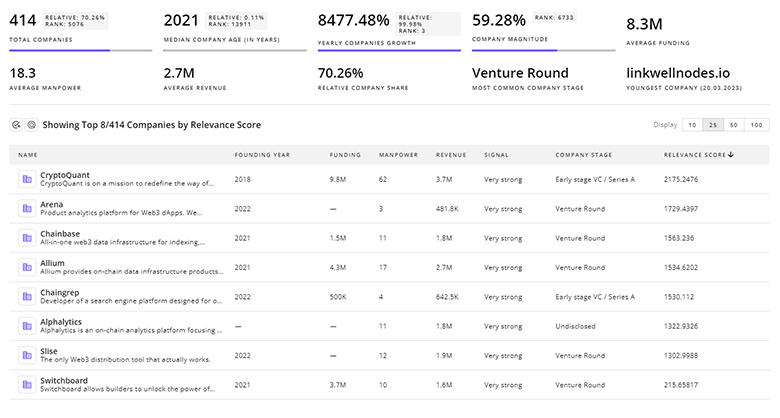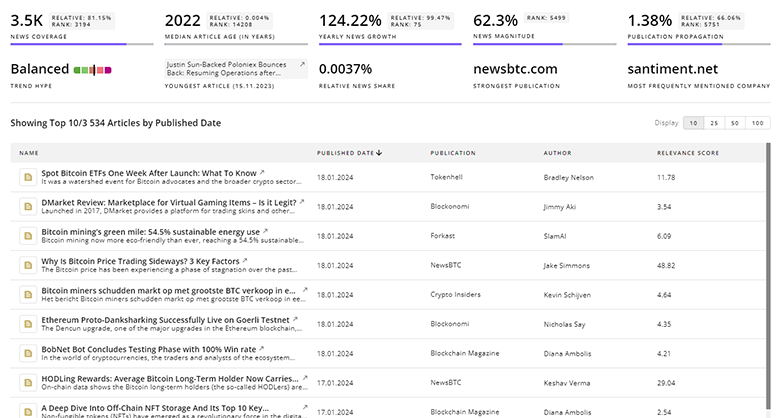
Drug Delivery Report
: Analysis on the Market, Trends, and TechnologiesThe drug delivery sector sits at a clear inflection point: the internal data records a market size of USD 2.10 billion in 2022 and projects USD 3.25 billion by 2028 at a 7.7% CAGR, signaling rapid commercialization of next-generation delivery platforms. Market research outside the internal dataset corroborates multi-billion dollar scales for device and pharmaceutical delivery segments and highlights strong growth in oral, injectable, and nanotechnology-enabled approaches, underpinned by rising chronic disease burden and wider adoption of self-administration models
We updated this report 3 days ago. Noticed something’s off? Let’s make it right together — reach out!
Topic Dominance Index of Drug Delivery
The Topic Dominance Index trendline combines the share of voice distributions of Drug Delivery from 3 data sources: published articles, founded companies, and global search
Key Activities and Applications
- Development and commercialization of injectable and auto-injector systems for biologics and long-acting therapies; industry focus expands to add connectivity and dose-tracking features thebusinessresearchcompany.com.
- Expansion of transdermal patches and microneedle platforms for chronic indications (pain, CNS, hormone replacement) and vaccines, driven by pipeline activity and multiple company programs
- Nanocarrier-based targeted delivery for oncology and nucleic acid therapeutics (LNPs, liposomes, polymeric nanoparticles) to improve therapeutic index and enable systemic RNA/drug programs
- Oral and transmucosal platforms aimed at replacing injectable biologics (oral peptides, thin films, enteric devices) to raise adherence and lower care-site burden Research & Markets overview.
- Pulmonary and intranasal delivery for local and systemic therapies (respiratory disease, rapid CNS access) supported by device advances in dry powder and nasal spray technologies openPR – Drug Delivery Systems Market Size.
Emergent Trends and Core Insights
- Nanocarriers scale from research to clinic. LNPs and other nanoparticle platforms now underpin mRNA/nucleic acid programs and drive demand for scalable nanoparticle manufacturing and regulatory clarity
> So what: Companies that secure GMP-grade, continuous nanoparticle production and demonstrate consistent safety profiles gain outsized commercial optionality for multiple payloads. - Patient self-administration moves from convenience to a market requirement. Connected autoinjectors, wearable pumps, and smart patches address adherence and decentralize care, increasing addressable market in home care settings thebusinessresearchcompany.com.
> So what: Device makers that embed reliable telemetrics will command premium pricing and form strategic partnerships with payers and pharma for bundled care models. - Transdermal and microneedle platforms become mainstream for both small molecules and biologics. Active and dissolvable microneedles are moving through clinical pipelines for vaccines, CNS, and chronic conditions
> So what: Microneedle innovators can compete on user experience and supply chain simplicity versus injectable biologics. - AI and high-throughput design accelerate formulation optimization. Firms integrate machine learning to predict carrier-payload compatibility and speed candidate selection
> So what: Startups that combine validated predictive models with experimental scale-up workflows will reduce time-to-clinic and increase investor interest. - Geographic redistribution of opportunity. North America retains share for premium, regulated products while Asia-Pacific shows fastest adoption and manufacturing scale for devices and generic delivery systems IMARC Group – Pharmaceutical Drug Delivery databridgemarketresearch.com.
> So what: Commercial strategies should split regulatory, clinical, and manufacturing pathways across regions to optimize cost and speed.
Technologies and Methodologies
- Lipid nanoparticles and polymeric nanocarriers for nucleic acid and oncology payloads; emphasis on surface functionalization for active targeting and improved PK.
- Microneedle arrays (dissolvable and coated) and hollow microstructured patches for minimally invasive vaccination and chronic dosing
- Wearable infusion and patch pumps including electro-osmotic and microfluidic delivery for controlled subcutaneous/continuous administration Research and Markets – Nanoengineered Biomaterials for Advanced Drug Delivery.
- Stimuli-responsive and programmable release systems (ultrasound, focused ultrasound, temperature or pH triggers) for on-demand local delivery Research and Markets – Innovations in Small Molecule Drug Delivery and Formulation.
- Continuous nanoparticle manufacturing and microfluidics for reproducible, scalable production of complex carriers
Drug Delivery Funding
A total of 1.1K Drug Delivery companies have received funding.
Overall, Drug Delivery companies have raised $102.2B.
Companies within the Drug Delivery domain have secured capital from 5.0K funding rounds.
The chart shows the funding trendline of Drug Delivery companies over the last 5 years
Drug Delivery Companies
- Mepsgen — Mepsgen positions itself as a scalable nanoparticle CDMO and engineering partner, focusing on continuous manufacturing for lipid and polymer nanoparticles; the company recently closed a Series C to expand capacity and serve RNA and oncology programs. Mepsgen targets pharma clients that require GMP nanoparticle runs and emphasizes automated, reproducible synthesis to reduce batch variability. Its value lies in bridging design and commercial production for high-value payloads.
- Nanexa — Nanexa develops depot and controlled-release platforms that extend dosing intervals for peptide and small molecule therapies; clinical-stage programs include a GLP-1 depot for metabolic indications and a one-month depot concept Nanexa differentiates through formulation expertise that targets sustained systemic exposure while minimizing peak-related adverse effects. The company appeals to pharma partners seeking lifecycle management for existing compounds.
- Medherant — Medherant advances transdermal TEPI patch technology for small molecules and analgesics and recently announced collaborations to expand commercial development; its patch format focuses on high drug loading and stable skin delivery. Medherant offers a lower-cost, patient friendly alternative to injections for chronic pain and hormone therapies, targeting outpatient and homecare use cases.
- Nanomedsys — Nanomedsys develops nanoporous and nanoparticle carriers for targeted cancer and CNS delivery and explores technologies to cross the blood-brain barrier; the firm features microfluidic synthesis workflows aimed at reproducibility. Its value proposition centers on enabling difficult-to-deliver biologics and small molecules to reach privileged tissues with controlled release profiles.
- PassPort Technologies — PassPort develops microporation transdermal technologies for rapid absorption and improved bioavailability (nasal and dermal microporation); clinical data indicate enhanced uptake for selected molecules and advancing programs for CNS and pain indications PassPort targets partners seeking to convert injectable regimens into user-friendly transdermal formats.
Gain a better understanding of 3.1K companies that drive Drug Delivery, how mature and well-funded these companies are.

3.1K Drug Delivery Companies
Discover Drug Delivery Companies, their Funding, Manpower, Revenues, Stages, and much more
Drug Delivery Investors
Gain insights into 3.5K Drug Delivery investors and investment deals. TrendFeedr’s investors tool presents an overview of investment trends and activities, helping create better investment strategies and partnerships.

3.5K Drug Delivery Investors
Discover Drug Delivery Investors, Funding Rounds, Invested Amounts, and Funding Growth
Drug Delivery News
Gain a competitive advantage with access to 21.6K Drug Delivery articles with TrendFeedr's News feature. The tool offers an extensive database of articles covering recent trends and past events in Drug Delivery. This enables innovators and market leaders to make well-informed fact-based decisions.

21.6K Drug Delivery News Articles
Discover Latest Drug Delivery Articles, News Magnitude, Publication Propagation, Yearly Growth, and Strongest Publications
Executive Summary
The data available show a market driven by three converging forces: advanced carriers (especially LNPs and multifunctional nanoparticles), devices that enable self-administration and real-time adherence data, and manufacturing scale that converts laboratory innovations into reproducible commercial products. For investors and commercial teams, the highest near-term value sits with firms that solve scale and reproducibility for nanoparticle platforms, integrate reliable connectivity into drug-device combinations for home care reimbursement, and demonstrate clear clinical benefit for transdermal or sustained-release replacements of frequent injectable regimens. Companies that align regulatory strategy, manufacturing capacity, and digital health partnerships will lead the next wave of commercial adoption.
We seek partnerships with industry experts to deliver actionable insights into trends and tech. Interested? Let us know!












